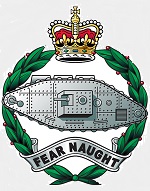Wings of the Great War WW10201 British Mark IV Female Heavy Tank - #245, "White-Red-White", Ashford, Kent, England (1:72 Scale)
"Through Mud And Blood To The Green Fields Beyond."
- British Tank Corps Motto in World War I
 The "Female" tank was a type of armoured fighting vehicle deployed during the First World War that carried multiple machine guns, instead of the mix of machine guns and cannons mounted by the original Mark I tank.
The "Female" tank was a type of armoured fighting vehicle deployed during the First World War that carried multiple machine guns, instead of the mix of machine guns and cannons mounted by the original Mark I tank.
The prototype, nicknamed "Mother", and the first production models of what would become referred to as the Mark I were designed to carry two six-pounder guns and three machine-guns. Lieutenant-Colonel Ernest Swinton expressed the fear that tanks armed in such a way might be unable to protect themselves from attacks by large numbers of enemy infantry. In April 1916, it was therefore decided that half of the 150 tanks on order should be fitted with machine guns in place of the six-pounders. A new sponson was designed so that the tank could carry two Vickers machine guns, with their cooling jackets protected by armoured sleeves, on each side of the hull. Swinton's idea was that tanks should operate in pairs: a "destroyer" and a "consort" or "man-killing" tank, providing mutual protection. He stated that he then assigned the names "male" and "female" respectively. The designation "male" applied to those armed with six-pounder guns, whereas the "female" was the tank equipped only with machine guns.
A consequence of these designations was that the prototype Mother became a "male" tank.
The design of the female sponson allowed only a very small door, which made escape from the vehicle extremely difficult. From the Mark II onwards, a new design was introduced that was smaller, incorporated Lewis or Hotchkiss guns, and allowed for much larger doors.
Both male and female tanks took part in the first tank action, on September 15th, 1916, at the Battle of Flers-Courcelette.
In 1918 it was decided that tanks should be 'hermaphrodites', simultaneously male and female, carrying both heavy armament and lighter machine guns. For the WWI tanks, this was achieved by fitting them with one sponson of each type. A mixed ability armament of the heavy gun and multiple machine guns also became common practice on turreted designs, without sponsons. This has become the standard model for tank designs since World War I and since then the terms "male" and "female" have been disused.
The basic idea underlying the concept of female tanks was widely used in design of light tanks and the first British infantry tanks in the years leading to World War II. Some armour of the WWII period, such as the German Ferdinand tank destroyer, were exclusively 'male', having only their heavy gun. These were found to be susceptible to infantry attack and so a defensive MG was added in the improved version, the Elefant
Pictured here is a 1:72 scale replica of a British Mark IV "Female" tank on display in the town of Ashford, in Kent, England.
Sold Out!
Dimensions:
Length: 4-1/2-inches
Width: 2-1/4-inches
Release Date: August 2016
Historical Account: "Battle History" - The Mark IV was first used in large numbers on June 7th, 1917, during the British assault on Messines Ridge. Crossing dry but heavily cratered terrain, many of the sixty-plus Mark IVs lagged behind the infantry, but several made important contributions to the battle. By comparison, at the Third Battle of Ypres (also known as Passchendaele) from July 31st, where the preliminary 24-day long barrage had destroyed all drainage and heavy rain had soaked the field, the tanks found it heavy going and contributed little; those that sank into the swampy ground were immobilized and became easy targets for enemy artillery.
Nearly 460 Mark IV tanks were used during the Battle of Cambrai in November 1917, showing that a large concentration of tanks could quickly overcome even the most sophisticated trench systems.
In the aftermath of the German Spring Offensive on the western front, the first tank-to-tank battle was between Mk IV tanks and German A7Vs in the Second Battle of Villers-Bretonneux in April 1918.
About 40 captured Mark IVs were employed by the Germans as Beutepanzerwagen (The German word Beute means "loot" or "booty") with a crew of twelve. These formed four tank companies from December 1917. Some of these had their six pounders replaced by a German equivalent.
The last Mark IV to see service was Excellent, a Mark IV male retained by the naval gunnery school on Whale Island, HMS Excellent. In the early years of the Second World War it was restored to operational status and driven to the mainland, where its new career was allegedly brought to an early end after a number of cars were damaged.


